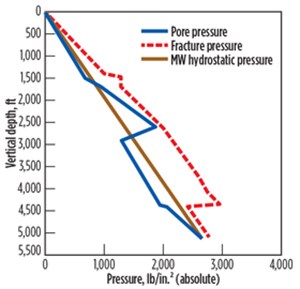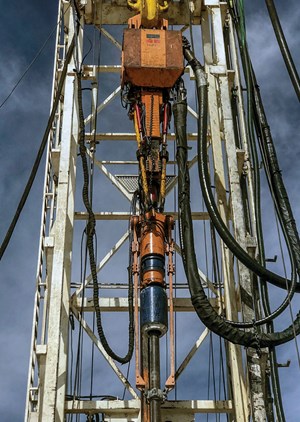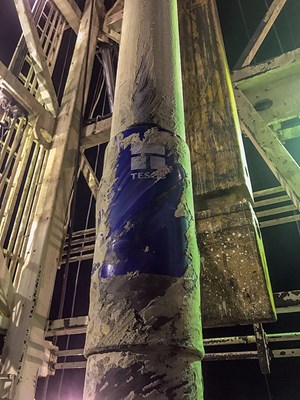Casing while drilling eliminates off-bottom events in a CO<sub>2</sub> flooded area
Tesco Corporation and a major oil company recently demonstrated how casing while drilling (CwD) technology can reduce operational time and save money while conducting a 2017 drilling strategy in the northwest Permian basin.
The formations in this area created overwhelming challenges due to several off-bottom events, which resulted in a minimal six-well pilot phase in 2011. In 2015, drilling recommenced with a 19-well expansion phase utilizing conventional drilling methods, but the expansion was halted in January 2016, with only six wells drilled. Drilling recommenced in July 2017 after evaluating various drilling strategies to reach the estimated 5,200-ft depth pay zone more efficiently, with reduced and predictable drilling costs.
CHALLENGES
The formations presented well integrity challenges and geological uncertainties that needed to be addressed before the expansion program could continue. No gas monitoring and GC tracer data was available from the 2011 and 2015 programs, making it difficult to assess the gas hazards for future wells.
Unstable formations, due to past injection activities, were expected to increase well integrity challenges. These activities included more than 40 years of operations such as artificial lift with CO2 and water flood, that exceeded overburden pressures. Active wells from the 1930s to 1960s may have had annular migration of CO2/hydrocarbon gas communicating through the shallow salt/anhydrite packages between the Salado (estimated 1,700-ft depth) and Yates (estimated 2,800-ft depth) formations. The Yates formation also contains naturally occurring nitrogen gas, which can be difficult to discern from harmful gas, so a safer solution was needed for drilling and cementing challenges that had affected earlier wells.

The saturated brine system is a common mechanism used to prevent excessive salt washouts in the Salado formation (estimated depth of 1,700 to 2,600 ft) and it is cost-effective with stable formations below the Yates. However, it was less effective while drilling below the base of the Grayburg formation (estimated 4,200-ft depth). In preparation for entering the depleted/weak zones of the upper San Andres, an estimated 4,350-ft depth, the clear drilling fluid was mudded up above the Grayburg formation, which was an estimated 4,000-ft depth, to prevent minor seepages or even a complete loss of returns—a phenomenon that was experienced while drilling previous wells.
Earlier wells experienced 20 to 60 bbl/hr losses of mud and were remedied with loss circulation materials, adding significant cost to the overall drilling program. As drilling reached TD of the well in the lower San Andres, which was an estimated 4,500-ft depth, the flowrates would need to be reduced in anticipation of equivalent circulating density (ECD) gained from weighing up the system by an additional 0.5 to 1 lb/gal. A heavier mud cap also would need to be placed as a trip margin to prevent influx from the shallower gas zones.
Once TD was reached, it was often problematic to keep the well overbalanced to control the shallow gas, without breaking out the bottom or ending up with cross-flows. With the presence of shallow gas and depletions below, keeping the well static was often time limited. When managing slow trip speeds to reduce ECD, the well was moderately seeping, and so differential sticking became an apparent risk. Typical well design practices would suggest setting another string of casing after the pore pressure and fracture pressure charts were observed, Fig. 1.
STRATEGY ANALYSIS
In 2011, the initial well AFE did not account for the well integrity and formation difficulties that ultimately led to unexpected non-productive time (NPT), as additional rig time was added and as the operator attempted to contain losses. Losses of up to 60 bbl/hr increased cost due to the need for added resources and equipment. Ultimately, the average cost per well ballooned by 71%, as each well took an average of 10.28 days to complete.
In 2015, 19 wells were planned with a drilling program that relied on the same historical drilling strategy. Previous lessons learned were applied to combat the wellbore challenges. In anticipation for formation difficulties, the new AFE was increased 30% compared to the 2011 AFE, but once again, significant NPT was accrued, which consumed additional resource and equipment costs. After only six wells, the program was halted, owing to the cost per well which increased 65% compared to the 2011 AFE, and almost 30% from the 2015 well completion AFE. While it reduced overall equipment and resources, NPT was unchanged, as each well took an average 10.32 days to drill.
Throughout 2016, the operator completed a thorough post-drilling analysis of the past drilling strategy to find a solution that would not only save overall drilling costs, but that would have more predictable performance from well to well. Managed pressure drilling (MPD)/underbalanced drilling (UBD), casing while drilling (CwD) and three-string contingency strategies were evaluated to determine the best solution for this field and the challenges it presented.
A decision tree was created to analyze the costs associated with both strategies, compared to the three-string contingency design and historical drilling practices. The weighted averages of the program from MPD/UBD and three-string contingency strategies were expected to cost 10% more than the expected cost of the CwD strategy. MPD/UBD and CwD strategies were expected to save two days compared to the three-string strategy. But, there was more value expected from the CwD after the quantitative analysis.
SOLUTION AND PREDICTABILITY
The smearing of cuttings, in combination with the lithology, worked together to seal off any permeable formations and resulted in no fluid loss or in some cases, only minor seepages. It would also mitigate differential sticking and significantly reduce cost from fluid usage and trucking.

By eliminating the need to pull out of hole after TD was reached, the wellbore could be circulated continuously and could avoid off-bottom well control situations from occurring. This would improve the cement bond and mitigate gas migration that plagued earlier wells due to poor cementation.
While CwD addressed most of the problems that caused previous strategies to be unsuccessful and unpredictable, new issues associated with CwD needed to be addressed and planned for, in order to ensure a predictable outcome. The new issues included the potential for reduced bit life and slower ROP (non-motor assist), external casing coupling wear and fatigue, and the inability to control deviation without steering capability.
The operator and Tesco worked together to create a simple, low-cost design that would mitigate the problems. The design premise of the drillstring with casing would consist of the bit, a bit crossover sub, a float sub, a packed assembly with crimp-on centralizers and an annulus casing packer (ACP) up to the Tesco casing drive system, Fig. 2. A 5-in. full gauge PDC bit was selected for the wells, with larger step-outs, and a higher tangent inclination. Two spray-on centralizers were spaced approximately 10 ft apart on a 20-ft pup joint above the bit crossover, followed by four hard-faced (HF) centralizers on a single joint, just above the float/landing collar. All of these components provided near-bit stabilization to maintain the hole angle and prevent unnecessary wear on the bit.
After the first estimated 75 ft, centralizers were placed 4 in. from the connections to prevent external casing coupling wear and fatigue. One HF centralizer was used per joint of casing, until about 300 ft, and then, one was used for every two joints of casing to about 750 ft, to protect the casing from vibrational stresses, wear and fatigue, Fig. 3. From about 750 ft to about 1,500 ft, non-HF centralizers were utilized, placing one centralizer per two joints, followed by one centralizer per three joints to about 3,400 ft, past the neutral point to prevent buckling and centralize the casing.

Regular casing was used above about 3,400 ft inside the casing shoe, except for an additional spray-on centralizer that was placed above and below the ACP at about 4,000 ft. The ACP was pivotal at preventing gas migration that affected previous drilling programs during cementation. A hydraulically operated stage tool was placed below the float sub. It functioned to open at pressures above the rig pumps’ operating limit, as a contingency in case the bit nozzles were plugged off during cementing, to allow an alternate path for cement circulation.
In order to accommodate for drilling operating parameters, the casing and its connections needed to be upgraded. Therefore, casing was changed from 15.5 to 17 lb/ft to increase stiffness, provide more available bit weight and reduce buckling. The casing grade was changed from J55 to L80 to bear less wear and fatigue, and increase yield strength. Casing connections were the final upgrade to the casing, to allow higher operating torque and bending loads. The casing design that was more rigid prolonged the survivability of the casing and enabled a more vertical path without the need for steering capability.
RESULTS
In 2017, the drilling program recommenced to complete the remaining 13 wells, with an AFE 40% larger than the original 2011 per-well AFE. The initial plan employed conventional drilling methods from the casing shoe to an estimated 4,000-ft depth, just above the Grayburg, then pulling out of hole to re-enter with the CwD design string. This method decoupled the cross-flows and simultaneous hazards of shallow gas flows and severe losses. The first six wells were drilled and completed using this method, averaging 8.56 days/well. Optimizing drilling time and reducing flat time saved a full day of operations or approximately 5% in cost, compared to the planned AFE.
The next seven wells were completed utilizing CwD from the casing shoe drill-out to TD at about 5,200 ft. The elimination of trip and displacement times to pull out of hole with the conventional drilling assembly reduced cost 6%. Due to the plastering effect which reduced overall cuttings at surface and fluid consumptions, material and service efficiencies were increased 4%. The exclusion of directional service in the production hole saved another 4% in tool cost.
The program started out with a few complications on the first couple of wells, but learnings were gained and improvements were made on the implementations of the following wells. While drilling the first well, the stage tool experienced premature opening because of incorrect pin settings by the vendor. This was quickly corrected and applied on the subsequent wells.
While tripping in with the CwD assembly on a second well, the casing became mechanically stuck from the ledges caused by the initial conventional drillstring, and was freed by spotting acid. Additional wellbore conditioning was applied later, and a drilling-while-reaming sub was added to the initial conventional drillstring as a preventative measure for the remaining four wells. This was done to allow a stiffer CwD assembly to traverse through the previously drilled section without hang-ups. No other complications were experienced on the remaining wells after CwD was used to begin drilling out from the surface casing shoe, with casing.
The actual costs of the drilling program utilizing Tesco’s CwD from the shoe to TD was 22% less than the original CwD’s 2017 per-well AFE. When averaged with the first six wells, the total cost per well was 1% below the per-well AFE. The wells also averaged 7.7 days to complete, 0.3 days less than was expected and 2.5 days less than the historical drilling methods. This finding confirmed the predictable nature of the CwD strategy. Thus, when compared to historical drilling strategies, the operator stands to save 37% per well on future wells in the northwest Permian basin. ![]()
- Coiled tubing drilling’s role in the energy transition (March 2024)
- Shale technology: Bayesian variable pressure decline-curve analysis for shale gas wells (March 2024)
- What's new in production (February 2024)
- Using data to create new completion efficiencies (February 2024)
- Digital tool kit enhances real-time decision-making to improve drilling efficiency and performance (February 2024)
- E&P outside the U.S. maintains a disciplined pace (February 2024)
- Applying ultra-deep LWD resistivity technology successfully in a SAGD operation (May 2019)
- Adoption of wireless intelligent completions advances (May 2019)
- Majors double down as takeaway crunch eases (April 2019)
- What’s new in well logging and formation evaluation (April 2019)
- Qualification of a 20,000-psi subsea BOP: A collaborative approach (February 2019)
- ConocoPhillips’ Greg Leveille sees rapid trajectory of technical advancement continuing (February 2019)


